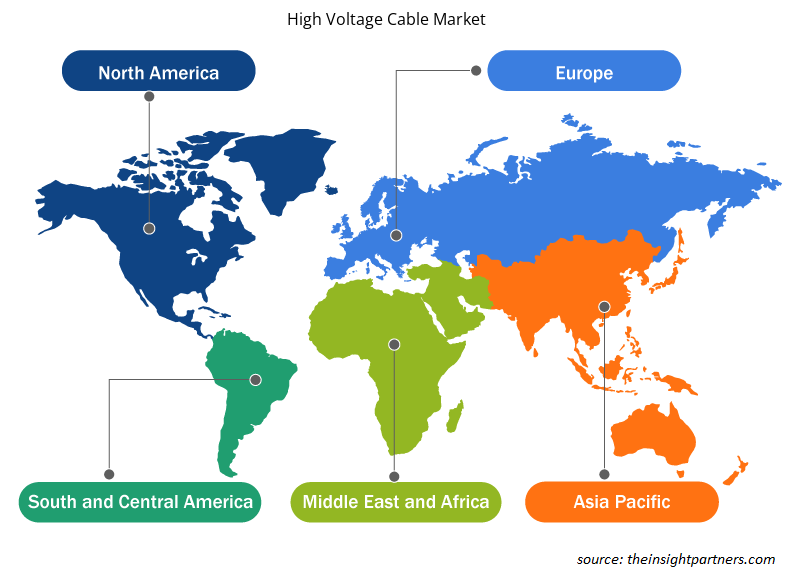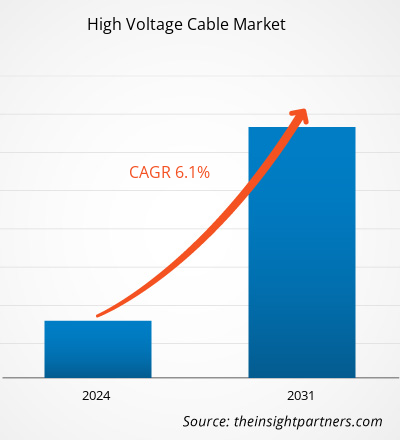Der Markt für Hochspannungskabel soll von 38,7 Milliarden US-Dollar im Jahr 2023 auf 62,2 Milliarden US-Dollar im Jahr 2031 anwachsen. Der Markt soll zwischen 2023 und 2031 eine durchschnittliche jährliche Wachstumsrate (CAGR) von 6,1 % verzeichnen. Die Notwendigkeit, die alternde Netzinfrastruktur zu ersetzen, und die Industrialisierung in Entwicklungsregionen dürften weiterhin die wichtigsten Trends auf dem Markt für Hochspannungskabel bleiben.
Marktanalyse für Hochspannungskabel
Der Markt für Hochspannungskabel hängt stark vom weltweiten Strombedarf ab. Der steigende Strombedarf dürfte dem Markt lukrative Wachstumsaussichten verschaffen. Darüber hinaus wird der Markt durch den Austausch veralteter Netzinfrastruktur und Übertragungsleitungen angetrieben. Darüber hinaus macht der Ausbau erneuerbarer Energiequellen wie Solar- und Windenergie den Aufbau neuer Versorgungsnetze sowie Übertragungs- und Verteilnetze erforderlich und ist somit ein wichtiger Markttreiber für Hochspannungskabel.
Marktübersicht für Hochspannungskabel
Hochspannungskabel sind Spezialkabel, die zur Übertragung und Verteilung von Strom bei hohen Spannungen verwendet werden. Diese Kabel sind mit Strukturelementen ausgestattet, darunter einem oder mehreren Leitern, Schutzmänteln und Isolatoren. Was Hochspannungskabel von anderen Typen unterscheidet, ist das Vorhandensein zusätzlicher Innenschichten im Isoliermantel, die dabei helfen, den elektrischen Fluss um den Leiter herum zu steuern. Diese Eigenschaft reduziert Stromverluste bei Übertragungen über große Entfernungen und macht Hochspannungskabel zur Stromübertragung effizienter als andere Arten von Spannungskabeln. Sie können als Freileitungskabel, unterirdische Kabel in der Industrie und sogar als Unterseekabel zur Stromübertragung zwischen Staaten und Ländern verwendet werden.
Passen Sie diesen Bericht Ihren Anforderungen an
Sie erhalten kostenlos individuelle Anpassungen an jedem Bericht, einschließlich Teilen dieses Berichts oder einer Analyse auf Länderebene, eines Excel-Datenpakets sowie tolle Angebote und Rabatte für Start-ups und Universitäten.
- Holen Sie sich die wichtigsten Markttrends aus diesem Bericht.Dieses KOSTENLOSE Beispiel umfasst eine Datenanalyse von Markttrends bis hin zu Schätzungen und Prognosen.
Treiber und Chancen auf dem Hochspannungskabelmarkt
Marktfördernd muss die veraltete Netzinfrastruktur ersetzt werden
Die Notwendigkeit, die veraltete Netzinfrastruktur zu ersetzen und das wachsende Smart Grid-Netzwerk zu integrieren, wird voraussichtlich das Wachstum des globalen Marktes für Hochspannungskabel vorantreiben. Da der Energiebedarf aufgrund von Bevölkerungswachstum und Urbanisierung weiter steigt, werden veraltete Netzsysteme durch moderne Smart Grids ersetzt, was den Aufbau neuer Übertragungsnetze erforderlich macht. Hochspannungskabel, die hohe Ströme über weite Entfernungen übertragen können, sind die bevorzugte Wahl für diese neuen Netze und treiben die erwartete Expansion des globalen Marktes in absehbarer Zukunft voran.
Einsatz erneuerbarer Energien bei der Stromerzeugung – eine Marktchance
Wachsende Umweltbedenken in Bezug auf Treibhausgasemissionen und der steigende globale Energiebedarf führen zu einer zunehmenden Nutzung erneuerbarer Energien bei der Stromerzeugung. Dies hat Länder dazu veranlasst, nach alternativen Lösungen zur Stromerzeugung zu suchen, wobei erneuerbare Quellen, insbesondere Wind- und Solarenergie, als die am meisten bevorzugten Optionen hervorgehen. Der verstärkte Einsatz erneuerbarer Energien erfordert den Bau neuer Übertragungsleitungen und treibt damit den globalen Markt an. Darüber hinaus haben Europa und Nordamerika ehrgeizige Pläne, die Kohlenstoffemissionen in naher Zukunft deutlich zu reduzieren, was den Markt für erneuerbare Energien und damit auch für Hochspannungskabel voraussichtlich erheblich ankurbeln wird.renewables necessitates the establishment of new transmission lines, thereby propelling the global market. Furthermore, Europe and North America have ambitious plans to significantly reduce carbon emissions in the near future, which is expected to substantially enhance the market for renewables and, consequently, high voltage cables.
Segmentierungsanalyse des Marktberichts für Hochspannungskabel
Wichtige Segmente, die zur Ableitung der Marktanalyse für Hochspannungskabel beigetragen haben, sind Typ und Endbenutzer.
- Je nach Typ ist der Markt in oberirdische, unterirdische und Unterwasserfahrzeuge unterteilt. Das oberirdische Segment hatte im Jahr 2023 einen bedeutenden Marktanteil.
- Nach Endverbraucher ist der Markt in Industrie, erneuerbare Energien und Infrastruktur segmentiert. Das Industriesegment hielt im Jahr 2023 einen erheblichen Marktanteil.
Marktanteilsanalyse für Hochspannungskabel nach geografischer Lage
Der geografische Umfang des Marktberichts für Hochspannungskabel ist hauptsächlich in fünf Regionen unterteilt: Nordamerika, Asien-Pazifik, Europa, Naher Osten und Afrika sowie Südamerika/Süd- und Mittelamerika.
Verschiedene Faktoren, darunter Regierungsinitiativen, Stromproduktion, Projekte für erneuerbare Energien und industrielle Aktivitäten, beeinflussen den Markt für Hochspannungskabel in Nordamerika. Erdkabel sind in Nordamerika aufgrund der steigenden Stromproduktion, erneuerbarer Energieprojekte und staatlicher Initiativen zur Unterstützung erneuerbarer Energieprojekte stärker verbreitet. Der Anstieg der Stromproduktion hat den Einsatz von Hochspannungskabeln weiter erhöht. Der Anstieg des Metallabbaus, der Öl- und Gasexploration und der Bautätigkeiten in Nordamerika dürften sich positiv auf die Nachfrage nach Hochspannungskabeln auswirken.
Regionale Einblicke in den Markt für Hochspannungskabel
Die regionalen Trends und Faktoren, die den Markt für Hochspannungskabel im Prognosezeitraum beeinflussen, wurden von den Analysten von Insight Partners ausführlich erläutert. In diesem Abschnitt werden auch die Marktsegmente und die Geografie von Hochspannungskabeln in Nordamerika, Europa, im asiatisch-pazifischen Raum, im Nahen Osten und Afrika sowie in Süd- und Mittelamerika erörtert.

- Erhalten Sie regionale Daten zum Markt für Hochspannungskabel
Umfang des Marktberichts für Hochspannungskabel
| Berichtsattribut | Details |
|---|---|
| Marktgröße im Jahr 2023 | 38,7 Milliarden US-Dollar |
| Marktgröße bis 2031 | 62,2 Milliarden US-Dollar |
| Globale CAGR (2023 - 2031) | 6,1 % |
| Historische Daten | 2021-2022 |
| Prognosezeitraum | 2024–2031 |
| Abgedeckte Segmente | Nach Typ
|
| Abgedeckte Regionen und Länder | Nordamerika
|
| Marktführer und wichtige Unternehmensprofile |
|
Marktteilnehmerdichte: Der Einfluss auf die Geschäftsdynamik
Der Markt für Hochspannungskabel wächst rasant, angetrieben durch die steigende Nachfrage der Endnutzer aufgrund von Faktoren wie sich entwickelnden Verbraucherpräferenzen, technologischen Fortschritten und einem größeren Bewusstsein für die Vorteile des Produkts. Mit steigender Nachfrage erweitern Unternehmen ihr Angebot, entwickeln Innovationen, um die Bedürfnisse der Verbraucher zu erfüllen, und nutzen neue Trends, was das Marktwachstum weiter ankurbelt.
Die Marktteilnehmerdichte bezieht sich auf die Verteilung der Firmen oder Unternehmen, die in einem bestimmten Markt oder einer bestimmten Branche tätig sind. Sie gibt an, wie viele Wettbewerber (Marktteilnehmer) in einem bestimmten Marktraum im Verhältnis zu seiner Größe oder seinem gesamten Marktwert präsent sind.
Die wichtigsten auf dem Markt für Hochspannungskabel tätigen Unternehmen sind:
- Dubai Cable Company - Ducab
- Furukawa Electric Co., Ltd.
- Nexans SA
- NKT A/S
- Prysmian-Gruppe (General Cable Corporation)
- Siemens AG
Haftungsausschluss : Die oben aufgeführten Unternehmen sind nicht in einer bestimmten Reihenfolge aufgeführt.

- Überblick über die wichtigsten Akteure auf dem Markt für Hochspannungskabel
Neuigkeiten und aktuelle Entwicklungen zum Hochspannungskabelmarkt
Der Markt für Hochspannungskabel wird durch die Erhebung qualitativer und quantitativer Daten nach Primär- und Sekundärforschung bewertet, die wichtige Unternehmensveröffentlichungen, Verbandsdaten und Datenbanken einschließt. Im Folgenden finden Sie eine Liste der Entwicklungen auf dem Markt:
- NKT erhält in Deutschland Aufträge für Hochspannungskabel im Wert von 1,2 Milliarden Euro. Das Unternehmen investiert 100 Millionen Euro (108,77 Millionen Dollar) in sein Werk in Köln, um die Kapazität bis 2027 schrittweise zu erhöhen. Der dänische Kabelhersteller NKT hat vom deutschen Übertragungsnetzbetreiber (ÜNB) Amprion einen Auftrag zur Lieferung von Hochspannungs-Wechselstrom- (AC) und -Gleichstrom- (DC) Landstromkabelsystemen erhalten.
(Quelle: NKT A/S, Unternehmenswebsite, 2024)
Marktbericht zum Hochspannungskabel: Abdeckung und Ergebnisse
Der Bericht „Marktgröße und Prognose für Hochspannungskabel (2021–2031)“ bietet eine detaillierte Analyse des Marktes, die die folgenden Bereiche abdeckt:
- Marktgröße und Prognose auf globaler, regionaler und Länderebene für alle wichtigen Marktsegmente, die im Rahmen des Projekts abgedeckt sind
- Marktdynamik wie Treiber, Beschränkungen und wichtige Chancen
- Wichtige Zukunftstrends
- Detaillierte PEST/Porters Five Forces- und SWOT-Analyse
- Globale und regionale Marktanalyse mit wichtigen Markttrends, wichtigen Akteuren, Vorschriften und aktuellen Marktentwicklungen
- Branchenlandschaft und Wettbewerbsanalyse, einschließlich Marktkonzentration, Heatmap-Analyse, prominenten Akteuren und aktuellen Entwicklungen
- Detaillierte Firmenprofile
- Historische Analyse (2 Jahre), Basisjahr, Prognose (7 Jahre) mit CAGR
- PEST- und SWOT-Analyse
- Marktgröße Wert/Volumen – Global, Regional, Land
- Branchen- und Wettbewerbslandschaft
- Excel-Datensatz
Aktuelle Berichte
Verwandte Berichte
Erfahrungsberichte
Grund zum Kauf
- Fundierte Entscheidungsfindung
- Marktdynamik verstehen
- Wettbewerbsanalyse
- Kundeneinblicke
- Marktprognosen
- Risikominimierung
- Strategische Planung
- Investitionsbegründung
- Identifizierung neuer Märkte
- Verbesserung von Marketingstrategien
- Steigerung der Betriebseffizienz
- Anpassung an regulatorische Trends























 Kostenlose Probe anfordern für - Markt für Hochspannungskabel
Kostenlose Probe anfordern für - Markt für Hochspannungskabel